LinkedIn Ads can be improved by using a combination of automation and AI to better achieve your goals. By leveraging Zapier, you can improve LinkedIn audience targeting, boost lead quality, and enhance lead management, ensuring that your marketing efforts are both efficient and effective.
In the rapidly evolving world of digital marketing, businesses need tools that can streamline their processes and enhance the effectiveness of their campaigns. Zapier allows marketers to automate repetitive tasks, saving time and effort, and enabling a more focused approach to strategy. When integrated with LinkedIn Ads, Zapier becomes a powerful asset for improving audience targeting, lead quality, and lead management.
In this blog post, we will delve into how Zapier’s marketing automation can be leveraged to maximise your LinkedIn Ads campaigns.
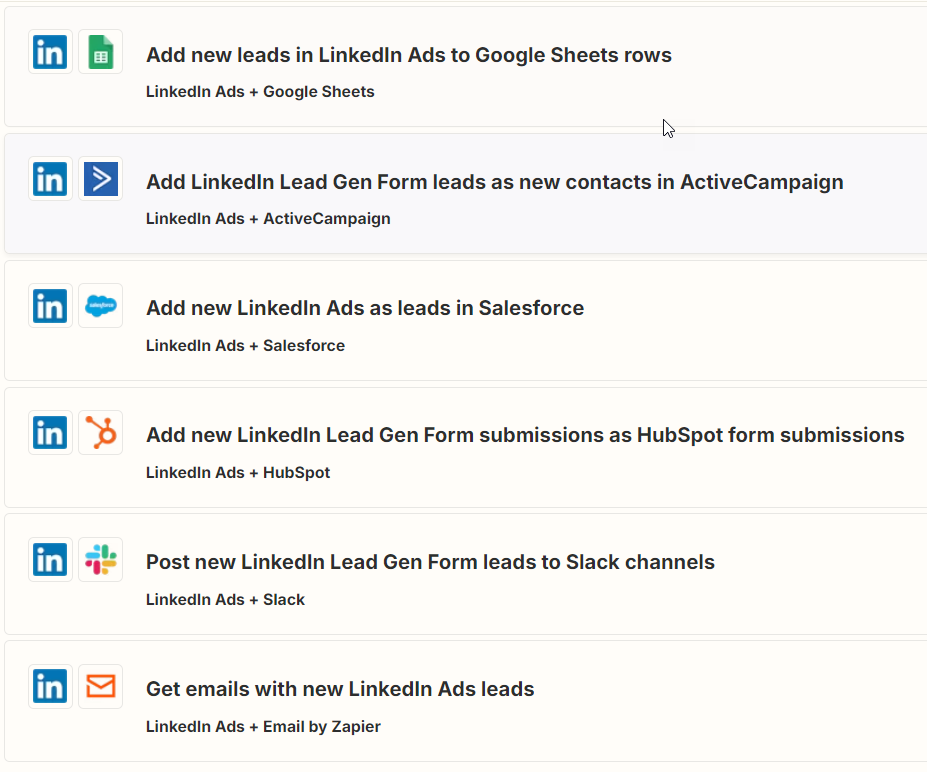
Understanding Zapier Automation
Zapier is an online automation tool that connects your favourite apps, such as Gmail, Slack, LinkedIn Ads, and over 3,000 others, to automate tasks without requiring any coding skills. It works by setting up workflows known as “Zaps,” which consist of a trigger and one or more actions. When a trigger event occurs in one app, Zapier performs a predefined action in another app.
For example, you can create a Zap that automatically updates your CRM with a new lead from LinkedIn Ads or update your matched audiences lists on LinkedIn when a lead reaches a certain stage in your CRM. By automating these repetitive tasks, Zapier allows you to focus on more strategic aspects of your ad campaigns.

The Benefits of using Zapier with LinkedIn Ads
Integrating Zapier with LinkedIn Ads unlocks a multitude of possibilities for automation and optimisation of your marketing ad campaigns.
By leveraging Zapier’s automation capabilities, businesses can streamline processes, improve targeting, and make data-driven decisions to elevate their LinkedIn Ads performance. This integration provides powerful tools to enhance audience targeting, improve lead quality, and streamline lead management, allowing businesses to maximise their advertising efforts.
By embracing automation and data-driven marketing, you can unlock the full potential of your LinkedIn Ads campaigns and drive greater success for your business. Here’s how Zapier can elevate your LinkedIn Ads performance:
Improving Audience Targeting
One of Zapier’s standout features is its ability to enhance audience targeting using your own first-party data to compliment the available 3rd party targeting offered by LinkedIn Ads.
Zapier advertising automation helps you create highly targeted audiences based on insights into customer behaviour and preferences using contact lists or company lists. Companies can be a cold target list of ICP (Ideal Customer Profiles) or a list of companies that have previously visited your website, identified by their IP addresses. This audience segmentation ensures that your ads reach the right people at the right time, maximising the chances of conversion.
For example, you can set up a Zap to automatically update your LinkedIn Ads audience lists based on changes in your CRM, such as a new company, purchase history or a contact lead’s stage status. This automation keeps your audience segments relevant, increasing the likelihood of conversions, as well as creating ad copy and landing pages.
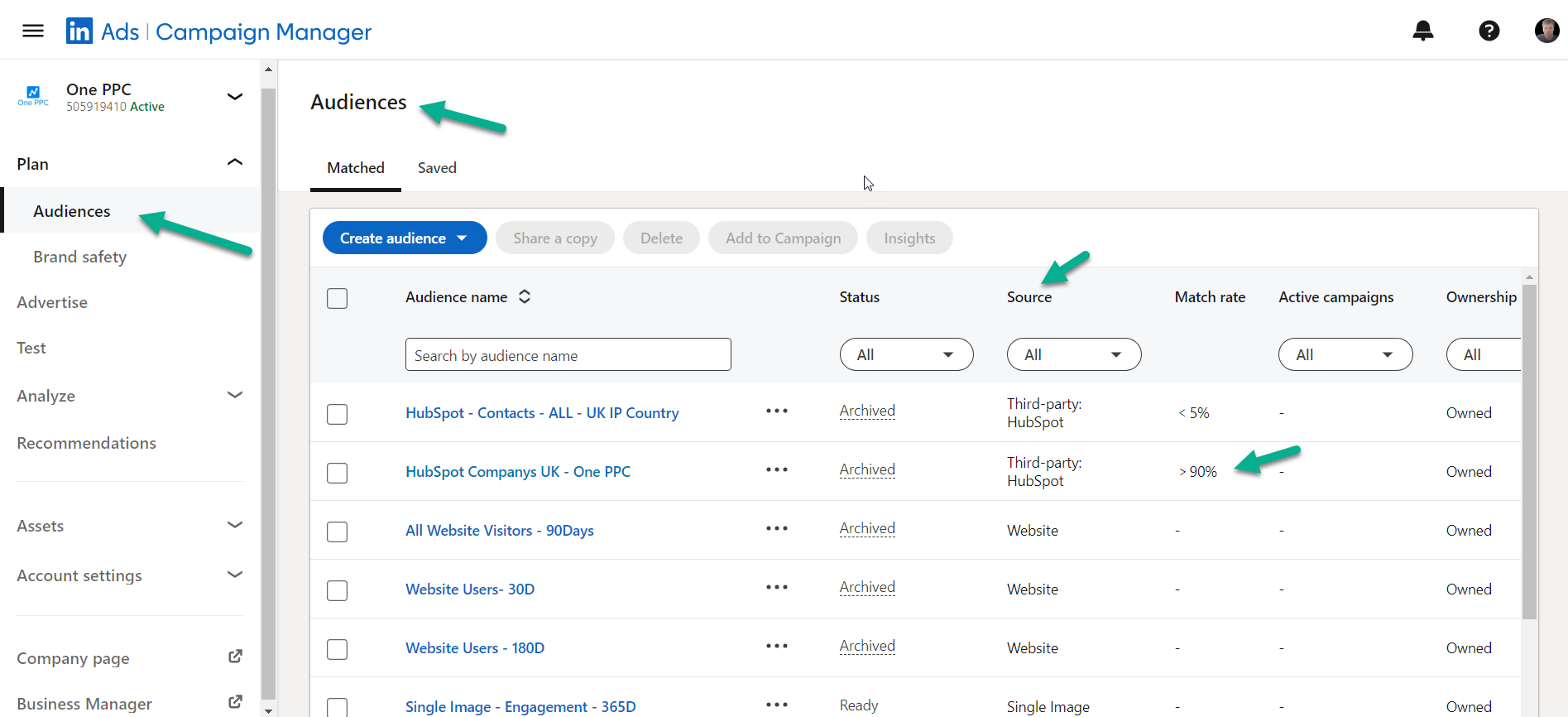
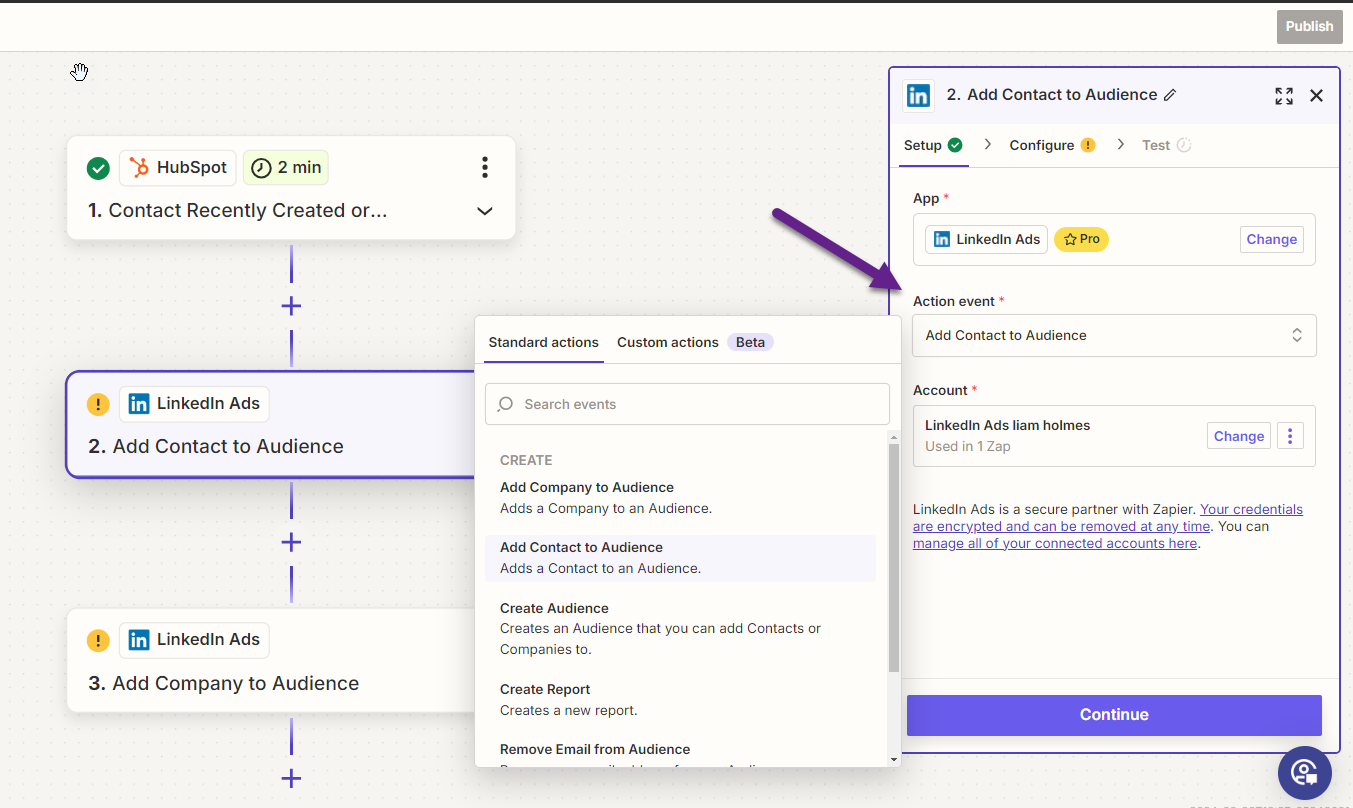
Improve Lead Quality with Offline Conversion Tracking
LinkedIn Ads offline conversion tracking is used to improve lead quality optimisation, taking advertisers beyond just focusing on cost per lead. When relying solely on online conversion tracking, you can use manual or automatic bidding strategies to generate as many conversions as possible at the lowest cost.
While this approach is effective for increasing the quantity of leads, it does not necessarily ensure the quality of those leads. To obtain better quality leads, it is essential to use offline conversion tracking to synchronise your lead lifecycle stages back to LinkedIn Ads, signalling lead quality. This integration allows the LinkedIn automatic bidding algorithm to differentiate between past leads, enabling it to optimise for future lead quality effectively. You also get better reports inside LinkedIn Ads for manual optimisation, and to confirm the AI is achieving your goals.
Using Zapier improves lead quality by integrating offline conversion tracking with LinkedIn Ads. This integration allows you to link offline actions, such as CRM sales cycle updates and offline purchases, to your online ad interactions, providing a comprehensive view of the customer journey.
By setting up Zaps that automatically upload offline conversion data to LinkedIn Ads, you gain valuable insights into which ads and campaigns drive the most valuable leads and customers.
For instance, if a lead progresses to a “Closed-Won” stage in your CRM, you can create a Zap that uploads this information as an offline conversion in LinkedIn Ads. This data helps refine your optimisation strategies, focusing on high-quality leads that are more likely to convert, and continuously optimises your marketing efforts for the best possible outcomes.
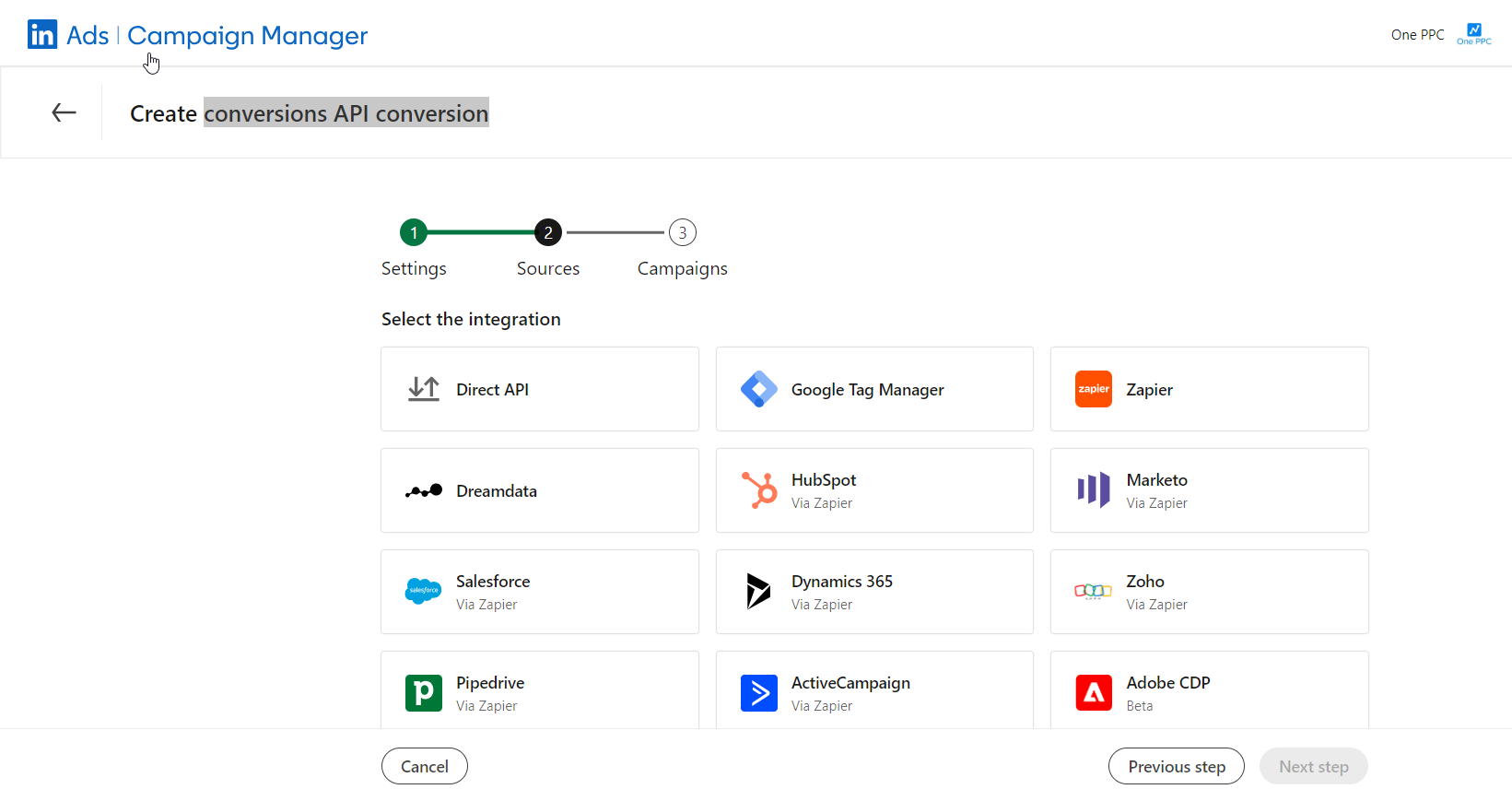
Improve Lead Management
Zapier’s automation capabilities significantly enhance lead management by ensuring that your sales team has timely access to accurate information. When a lead is generated through LinkedIn Ads, Zapier can automatically update your CRM with relevant data, such as the lead’s contact information.
Additionally, you can create Zaps that trigger follow-up actions based on lead activity, such as sending a welcome email, assigning the lead to a sales representative, or creating a task in your project management tool. This automation streamlines the lead management process, ensuring that leads are promptly and effectively nurtured, thereby increasing the likelihood of conversion.
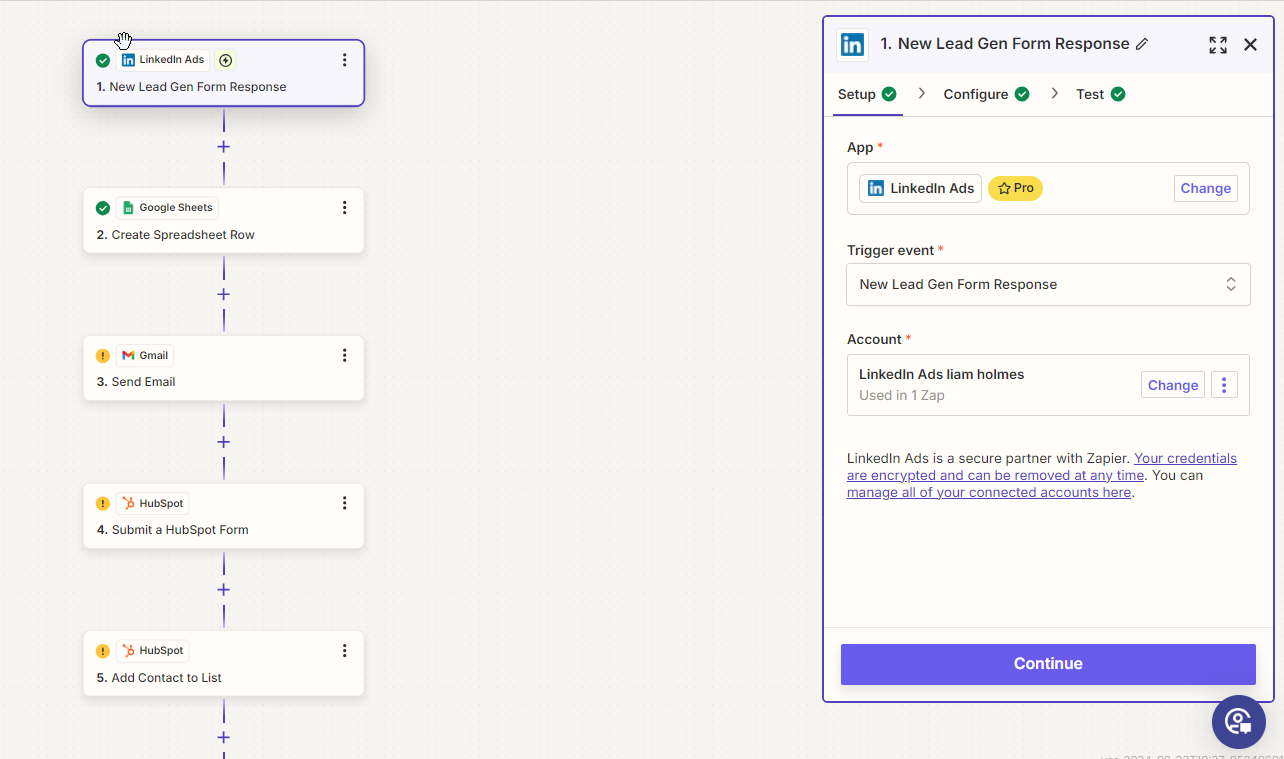
Getting Started with LinkedIn Ads & Zapier
To begin automating LinkedIn Ads with Zapier, you’ll need an account on both platforms. Once you have them, you can start building Zaps—workflows that connect different apps to perform automated tasks. Let’s explore some common use cases for automating LinkedIn Ads with Zapier.
To start using Zapier with LinkedIn Ads, follow these steps:
- Sign Up for Zapier:
- If you haven’t already, create a Zapier account. You can start with the free plan to explore basic features and upgrade as needed.
- Connect LinkedIn Ads and Other Apps:
- In Zapier, navigate to the “My Apps” section and connect your LinkedIn Ads account. You can use LinkedIn as a trigger app or action app.
- Connect other relevant applications, such as your CRM, email marketing platform, or project management tool.
- Create and Test Zaps:
- Identify repetitive tasks or processes that can be automated with Zapier.
- Create Zaps that automate these tasks, ensuring that each Zap has a clear trigger and action.
- Test your Zaps to ensure they function correctly and make adjustments as necessary.
- Activate and Monitor Zaps:
- Once your Zaps are set up and tested, activate them to start automating your workflows.
- Monitor the performance of your Zaps and make improvements as needed to optimise your processes.

1st Party Audience Targeting (LinkedIn & Zapier)
First-party targeting involves using data collected directly from your own audience or customers to create targeted marketing campaigns. This data can include information gathered from:
- Customer relationship management (CRM) systems (e.g. HubSpot, Salesforce, Pipedrive.)
- Shopping Carts (e.g. Shopify, WooCommerce)
- Email lists (e.g. Google Sheets, Mailchimp)
- Website analytics
- Purchase histories
- Engagement metrics from your apps or platforms
Unlike third-party data, which is collected by external companies like LinkedIn, first-party data is obtained directly from interactions between your business and its target market. This makes it more reliable, accurate, and compliant with privacy regulations.
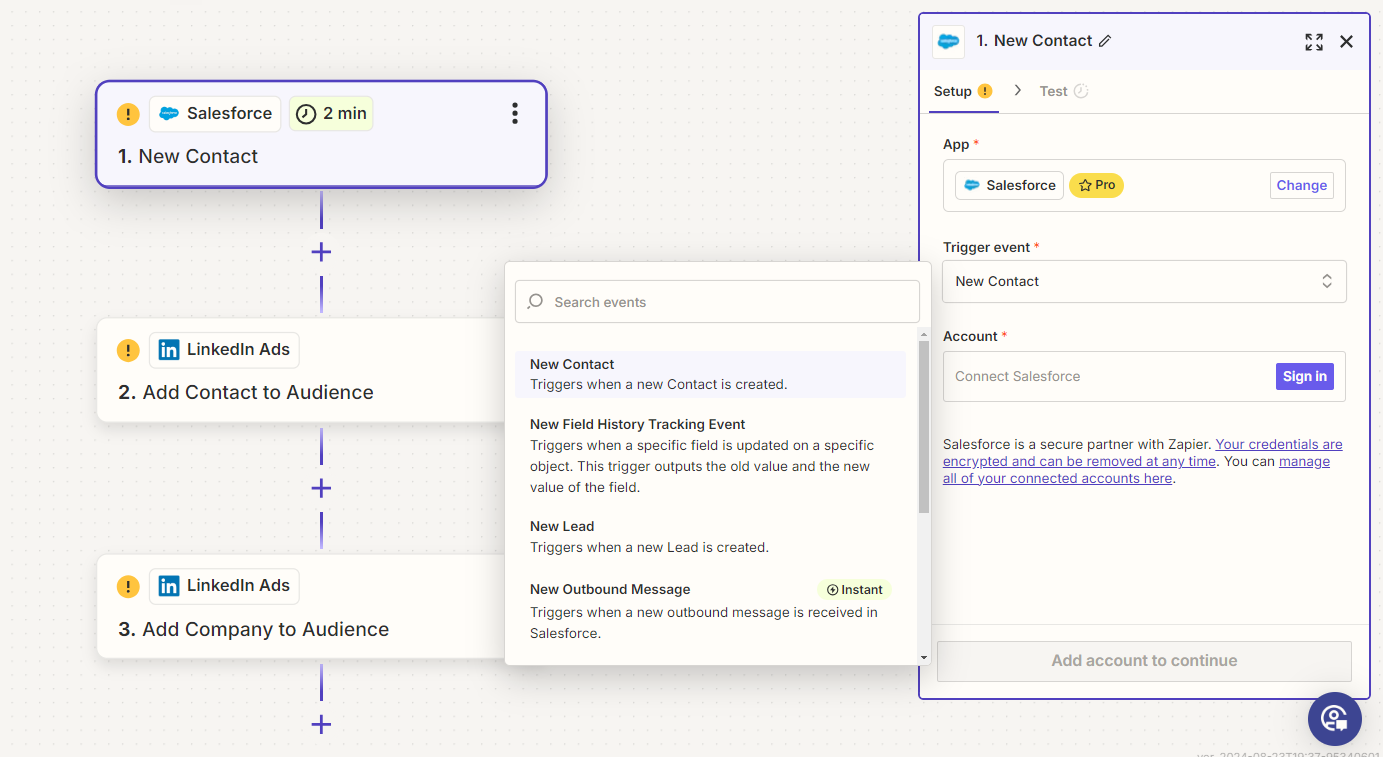
First-Party Targeting Benefits
Integrating Zapier with LinkedIn Ads for first-party targeting enhances your advertising capabilities by leveraging your own data to complement the third-party audience targeting provided by LinkedIn.
Increased Relevance & Personalisation: First-party data allows you to create highly relevant and personalised ad campaigns. You can tailor your messaging to match the specific interests and behaviours of your audience, improving engagement and conversion rates.
Improved ROI: By targeting users who have already interacted with your brand, you are more likely to achieve a better return on investment (ROI) on your ad spend. These users are already familiar with your brand, making them more likely to convert.
Enhanced Compliance: Using first-party data ensures better compliance with privacy regulations such as GDPR and CCPA, as you are utilising data collected with consent from your own audience.
Dynamic and Up-to-date Audience Lists: Zapier automation ensure that your audience lists in LinkedIn Ads are always up-to-date. Any changes in your first-party data, such as new sign-ups or customer information updates, are automatically reflected in your targeting lists.
Efficient Resource Management: Automating the data transfer process saves time and resources, allowing your team to focus on strategic tasks rather than manual data entry.
How to Setup First-Party Audiences
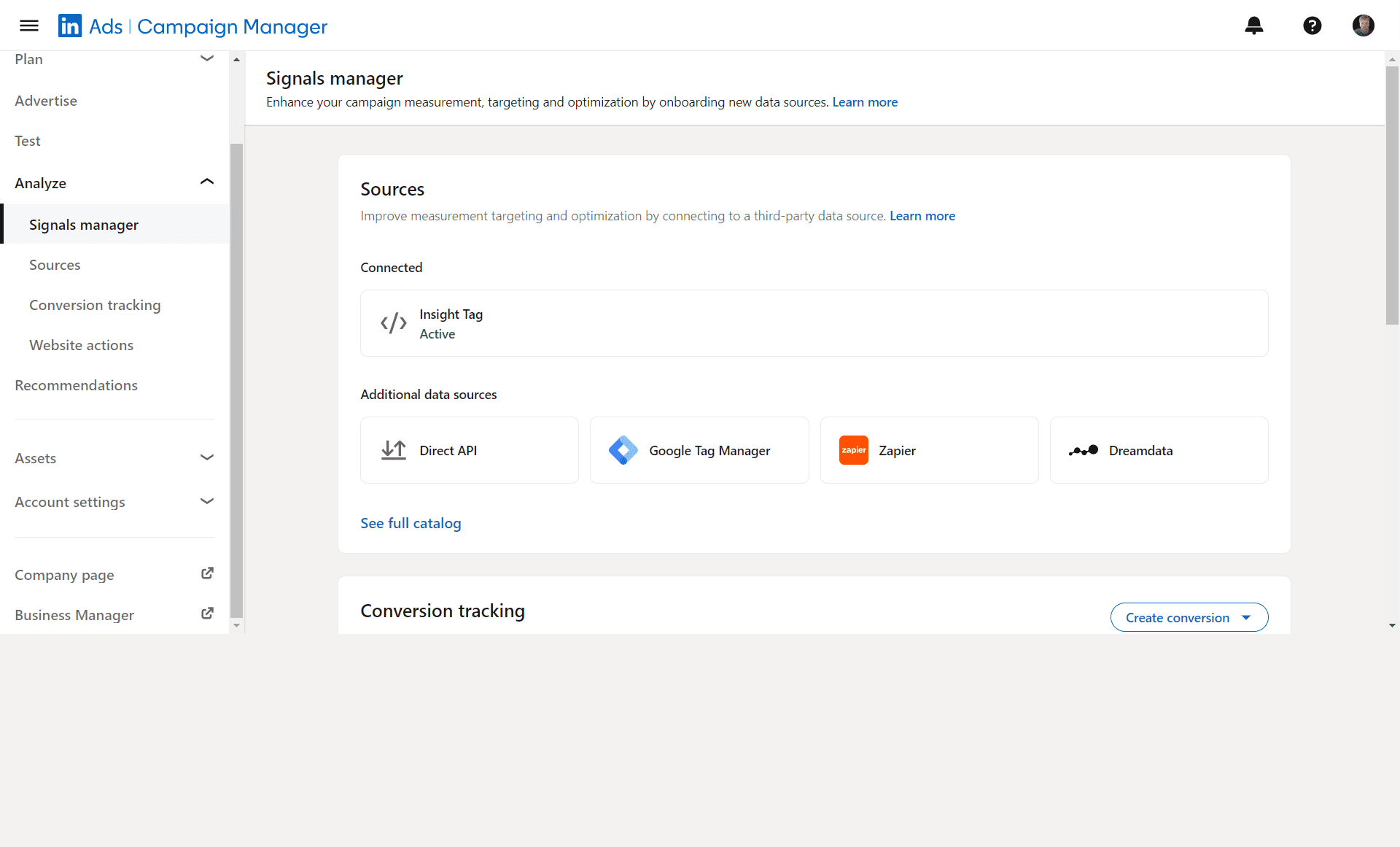
By connecting first-party data sources, such as CRM systems, and email marketing platforms to LinkedIn Ads via Zapier, you can automate the process of updating audience lists with real-time data.
The automation ensures that your audience lists in LinkedIn Ads are always current, empowering your marketing strategy with accurate and actionable insights from your own data.
Identify Your First-Party Data Sources
Before setting up the automation, determine where your valuable first-party data is stored. This could be:
CRM platforms like HubSpot, Salesforce, or Zoho
- Email marketing tools like Mailchimp or ActiveCampaign
- E-commerce platforms like Shopify or WooCommerce
- Form submission tools like Typeform or LinkedIn Forms
Create a LinkedIn Ads Matched Audience List
- Go to your LinkedIn Ads account.
- Click on “Audiences”.
- Click the “Create Audience” button in the top left corner
- Choose the type of Matched Audience
- Website retargeting
- Contact targeting (upload list)
- Account targeting (upload list)
- Connect CRM or upload your CSV file with the contact or company information.
Once processed, you can select the Matched Audience when setting up targeting for your LinkedIn ad campaigns
Example Zaps for LinkedIn Ads Audiences
With these examples Zaps (automated workflows), your contact and company (account) lists will stay updated with LinkedIn Ads audiences, allowing you to run targeted campaigns and improve lead quality.
Choose a Trigger: Select a trigger from your CRM or another contact management app. For example, you could choose “New Contact” or “New Company”
Select an Action: Choose an action in LinkedIn Ads, such as “Add Contact to Audience, or add company to audience.”
Configure the Zap: Map the contact information to the correct fields in LinkedIn Ads. You might create custom audiences based on different segments, like existing customers. ICP (Ideal Customer Profile) and high-value leads.
Test and Activate: Test the Zap to ensure contacts are synced correctly with LinkedIn Ads. Once verified, activate the Zap.
Further examples include:
New Lead List Zap:
- Trigger: Lead status changes in CRM (e.g. new lead).
- Action: Update LinkedIn Ads audience lists to include this new contact/lead.
Converted Lead List Zap
- Trigger: Lead status changes in CRM (e.g., lead becomes a customer).
- Action: Update LinkedIn Ads audience lists to exclude converted customers from prospecting campaigns and include them in upsell or cross-sell campaigns.
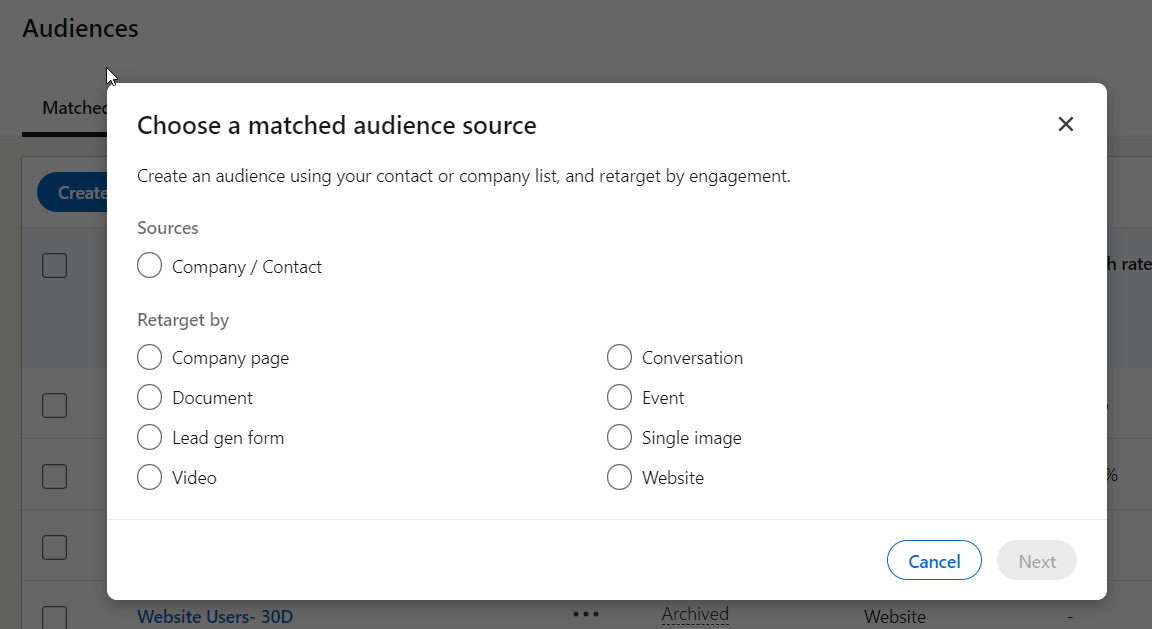
Improve Lead Management
Another common automation involves creating custom alerts for follow-up actions when new leads are captured by LinkedIn Lead Ads Forms. This ensures that your sales team is promptly informed and can take action to convert leads into customers.
By automating the transfer of lead data from LinkedIn Ads to your CRM, or email platform like Gmail or Outlook, you can ensure that your sales team receives timely and accurate information. This automation helps in identifying high-quality leads and prioritising follow-up actions.
- Trigger: New lead form submission in LinkedIn Ads.
- Action: Send a notification to your sales team via Slack or email and automatically assign the lead to a sales representative in your CRM.
Here’s how you can set up this automation:
- Select a Trigger: Setup LinkedIn Ads as the Trigger App, “New Lead.”
- Choose an Action: Select an action in your CRM, email app or project management tool. For example, you could choose “Send Email” to send an email alert when a new lead is created.
- Configure the Zap: Set up the details, such as the recipient’s email address and the content of the email alert. You might include key information about the lead taken from the lead ad form to help your team prepare for follow-up.
- Test and Activate: Test the Zap to ensure the alert is sent correctly. If all is well, activate the Zap.
This Zap helps streamline communication and ensures that leads are not overlooked, improving your chances of converting them into customers.

Offline Conversion Tracking
This integration with LinkedIn Ads allows advertisers to move beyond simple metrics like cost per lead and focus on more insightful measures, such as cost per customer conversion and revenue per conversion.
360 Degree Closed-Loop Reporting: Offline conversion tracking also improves reporting within LinkedIn Ads by providing data such as how many leads became qualified and eventually converted into customers, and even the sales revenue. This data enables advertisers to shift from basic online cost per lead metrics to more meaningful ones, such as cost per customer conversion and revenue per conversion, allowing for better strategic decision-making.
Improved Tracking and ROI: With a clearer understanding of the customer journey and lead quality, you can continuously optimise your marketing efforts for better outcomes, ultimately improving their return on investment (ROI). This comprehensive view of customer interactions helps ensure that advertising strategies are aligned with business goals and maximise the effectiveness of ad spend.
Maximise LinkedIn’s AI: Offline conversion tracking provides a significant advantage for advertisers who want to optimise lead quality rather than just focusing on the quantity of leads. By using offline conversion data, advertisers can maximise LinkedIn Ads bidding strategies (machine learning AI) to prioritise high-quality leads that are more likely to convert into customers. Want to learn more, see our blog post LinkedIn Ads Offline Conversion Tracking.
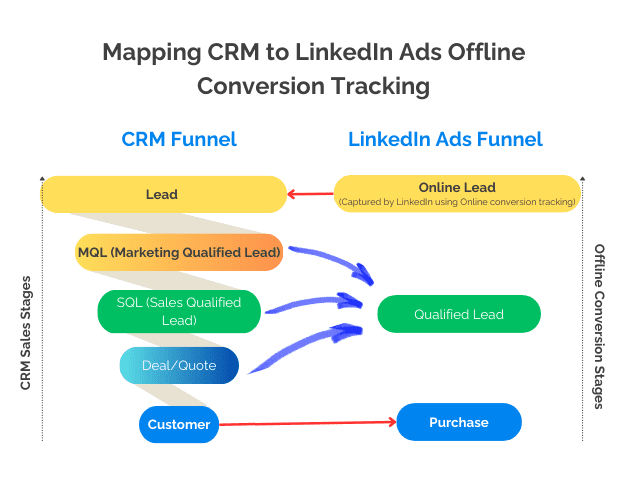
The Limitations of Online Conversion Tracking
When relying solely on online conversion tracking with manual or automatic bidding strategies in LinkedIn Ads the focus is to maximise the number of online conversions at the lowest possible cost. While this approach is effective for generating a high volume of leads, it does not always deliver the best lead quality.. Consequently, advertisers may end up with a large number of leads that are less likely to convert into paying customers. One type of lead may have a much higher sales revenue value, or be more qualified than leads leading to a higher likely hood of a sale.
The Role of Offline Conversion Tracking
To enhance lead quality, it is essential to utilise offline conversion tracking, which allows advertisers to synchronise lead lifecycle stages back to LinkedIn Ads. In this way, advertisers can signal lead quality to the LinkedIn Ads algorithm. This integration enables the automatic bidding algorithm to differentiate between past leads and optimise for the type of leads you believe are the best quality.
How Zapier Facilitates Offline Conversion Tracking
Zapier is an automation tool that simplifies the process of linking offline actions to online ad interactions. By creating automated workflows, known as “Zaps,” businesses can seamlessly upload offline conversion data to LinkedIn Ads. This integration provides a comprehensive view of the customer journey, allowing advertisers to gain valuable insights into which ads and keywords drive the most valuable leads and customers.
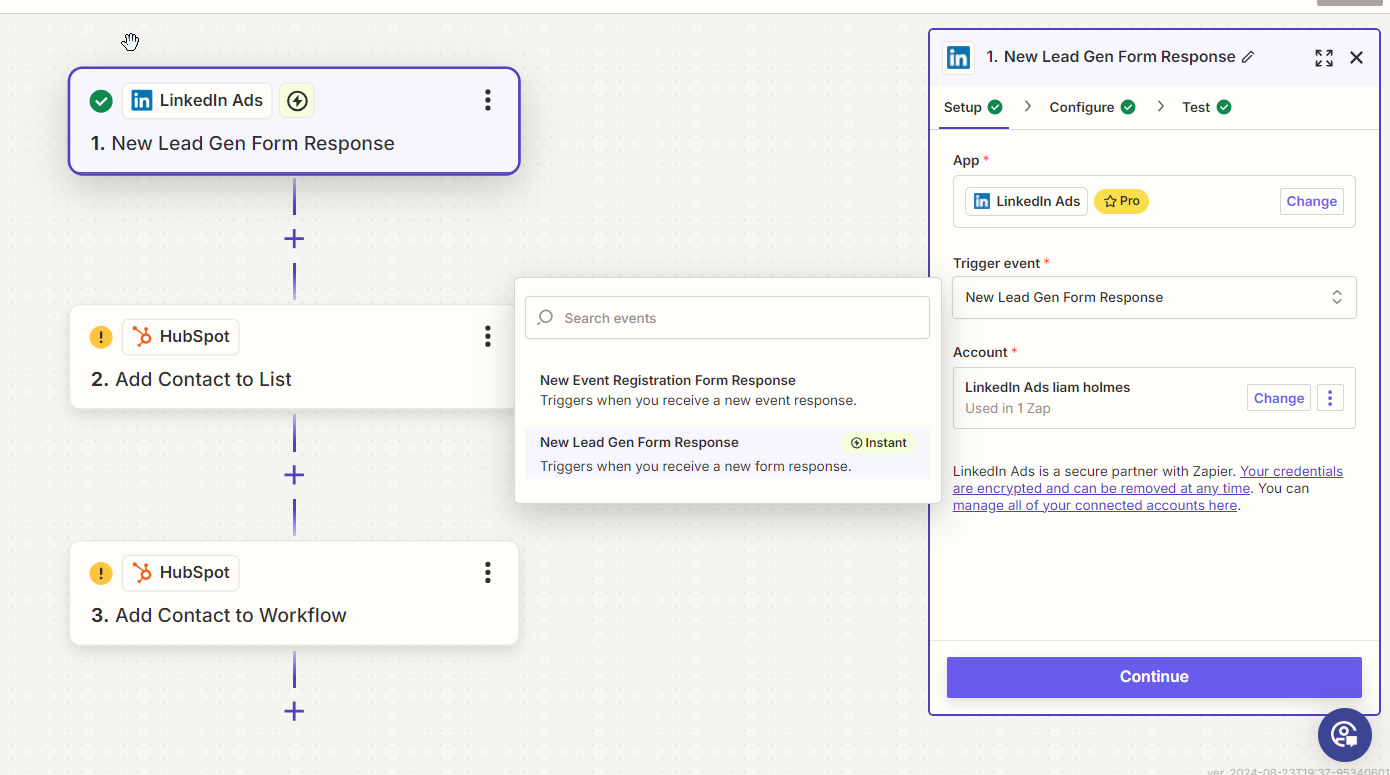

How to Setup LinkedIn Ads Offline Conversion Tracking
Sign in to your LinkedIn Campaign Manager account.
- Go to the “Analyze” dropdown menu and select “Conversion Tracking”.
- Click on “Create Conversion” and choose “Offline Conversion”.
- Name your offline conversion event (e.g., “In-Store Purchase” or “Phone Consultation”).
- Select the appropriate conversion type from the dropdown menu (e.g., Purchase, Lead, etc.).
- Enter the conversion value if applicable.
- Set the attribution window for clicks and views.
- Choose an attribution model (e.g., last touch).
- Save your offline conversion settings.
- Prepare your offline conversion data in a CSV file, including necessary fields like conversion time, conversion value, and LinkedIn click ID or view through ID.
- In Campaign Manager, go to the “Offline Conversions” section and click “Upload Conversions”.
- Select the CSV file you prepared and map the columns to the appropriate LinkedIn fields.
- Upload the file and wait for LinkedIn to process the data (may take up to 24 hours).
Once processed, you can view offline conversion data alongside online conversions in your campaign reports.
To automate this process, consider setting up an integration between your CRM or data management system and LinkedIn’s Conversions API. In the example below we have used Zapier API

Using Zapier to Setup Offline Conversion Tracking
Identify Key Offline Actions: Determine the offline actions that indicate a lead’s progression through the sales cycle. These actions may include CRM updates or in-store purchases, or online POS (Point of Sale) invoicing such as Stripe
Create Zaps for Data Upload: Set up Zaps in Zapier to automatically upload offline conversion data to LinkedIn Ads. For example, if a lead reaches the “Closed-Won” stage in your CRM, you can create a Zap that uploads this information as an offline conversion.
Map Data Fields: Ensure that the data fields in your CRM or other systems are correctly mapped to the corresponding fields in LinkedIn Ads. This mapping ensures accurate data transfer and reporting.
Test and Activate Zaps: Test the Zaps to confirm that data is flowing correctly and accurately from your offline sources to LinkedIn Ads. Once verified, activate the Zaps to automate the data transfer process.
Example Offline Conversion Zaps
Trigger: Update the lead stage in your CRM to reflect progress, such as moving from “Contacted” to “Qualified.” or “Closed-Won”.
Action: Upload offline conversion data to LinkedIn Ads, as sociating the conversion with the original ad click ID. To learn more, see our blog post: Using Zapier for LinkedIn Ads Offline Conversion Tracking
Conclusion
Whether you’re aiming to improve report and measurement, increase lead quality, streamline lead management, or enhance audience targeting, Embracing automation and data-driven marketing empowers you to maximise the effectiveness of your advertising efforts and achieve a higher return on investment.
Integrating Zapier and offline conversion tracking with LinkedIn Ads can transform your marketing efforts by automating workflows, enhancing data management, and providing valuable insights into campaign performance. By tracking offline conversions, you gain a complete view of the customer journey, enabling you to optimise audience targeting, improve lead quality, and make informed decisions to drive better results. This comprehensive approach allows you to unlock the full potential of your digital marketing strategy, ensuring that every pound spent on LinkedIn Ads contributes to your overall success
By continuously optimising your strategies, you can ensure that your marketing efforts remain efficient and effective. With the right strategy and tools in place, you can drive your business to new heights of success and make the most out of your LinkedIn Ads investments.